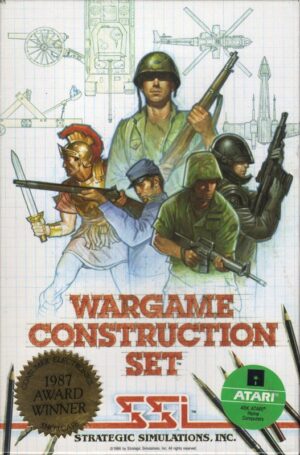Retro Replay Review
Gameplay
Hi-Res Adventure #0: Mission Asteroid presents a straightforward yet challenging gameplay loop that embraces the simplicity of early text-and-graphic adventures. You assume the role of a lone astronaut entrusted by Mission Control with a critical mission: intercept an asteroid headed for Earth and neutralize it. With no flight plan in hand, you must deduce the correct actions using one- and two-word text commands, such as “GET MAP” or “LAUNCH ROCKET.” Each input moves you closer to your goal or slows you down in a race against time.
(HEY YOU!! We hope you enjoy! We try not to run ads. So basically, this is a very expensive hobby running this site. Please consider joining us for updates, forums, and more. Network w/ us to make some cash or friends while retro gaming, and you can win some free retro games for posting. Okay, carry on 👍)
The game’s parser is unforgiving by modern standards but charming in its efficiency. You’ll type commands like “TURN ON RADAR” or “PUSH BUTTON” to navigate your spacecraft and explore a handful of static, high‐resolution screens. There are no extensive menus or inventory systems—every object you encounter can be examined, picked up, or used with a succinct verb-noun entry. This minimalism keeps you focused on puzzle-solving rather than inventory micromanagement.
Because Mission Asteroid is quite short, you can realistically complete it in one sitting, provided you don’t get stuck on a missed clue or mistyped command. The ability to save your progress to a floppy disk at any point is a welcome convenience, allowing you to experiment freely without fear of starting over. For retro gaming enthusiasts or newcomers curious about the roots of modern adventure games, this title delivers a tight, purpose-driven experience that hinges on logical deduction and careful observation.
Graphics
As one of the earliest entries in Sierra’s Hi-Res Adventure series, Mission Asteroid showcases static, hand-drawn screens rendered in high resolution for its time. Each scene—whether you’re in the cramped command module or hurtling through the void toward the asteroid—features crisp line art and a surprisingly detailed depiction of spacecraft controls, lunar surfaces, and distant stars. The visuals serve more to set the mood than to dazzle with motion or color depth.
Animations are minimal, limited to simple screen transitions when you move between locations or issue certain commands. This restraint places the emphasis squarely on your own imagination, bridging the gap between text-based storytelling and graphical flair. Though modern gamers may find the lack of dynamic movement jarring, there’s a nostalgic charm in pausing to study each frame for hidden clues or subtle hints.
Despite the limited palette and static framing, the art succeeds in conveying the isolation and urgency of a solo space mission. Instrument panels are drawn with clarity, guiding you toward the correct levers and switches you’ll need to operate. In an age before cinematic cutscenes, Mission Asteroid’s graphics strike a balance between functional design and evocative atmosphere—a testament to early adventure game craftsmanship.
Story
The narrative premise of Mission Asteroid is deceptively simple: a rogue asteroid threatens Earth, and humanity’s hope rests on your shoulders. There are no elaborate subplots or cast of supporting characters—just Mission Control’s terse instructions echoing through your communication console and the silent void you must traverse. This barebones framework keeps the focus tightly on your mission objective.
Throughout the adventure, you’ll uncover small bits of dialogue and on-screen text that flesh out the scenario: cryptic hints about the asteroid’s trajectory, snippets of background lore about the spacecraft, and the occasional offhand remark from Mission Control reminding you of the clock ticking down. While the story doesn’t delve into deep character development or moral quandaries, it effectively instills a sense of high stakes and personal responsibility.
This no-frills storytelling approach resonates with those who appreciate clarity of purpose. There are no red herrings or sprawling backstories to wade through—just you, your rocket, and one singular goal. In a modern context, it may feel brief, but as a piece of interactive history, it highlights the era’s emphasis on puzzle-driven narratives rather than cinematic spectacle.
Overall Experience
Playing Hi-Res Adventure #0: Mission Asteroid feels like stepping into a time capsule of gaming history. Its concise design, reliance on text commands, and static high-resolution screens represent a pioneering spirit in the early 1980s. Fans of retro gaming will appreciate how every command must be deliberate and how solving each puzzle yields a genuine sense of accomplishment.
However, newcomers accustomed to point-and-click interfaces or real-time action may find the rigid parser and sparse visuals somewhat daunting. The absence of in-depth dialogue trees or multiple endings means replay value is limited once you’ve mastered the solution. That said, the built-in save feature helps mitigate frustration, allowing you to experiment and learn without punitive restarts.
Ultimately, Mission Asteroid shines as a succinct, purpose-built adventure that laid groundwork for more elaborate titles in the Hi-Res Adventure line. Its educational value—in teaching logic, attention to detail, and the art of concise command input—remains intact. If you’re seeking a quick, historically significant experience that captures the essence of early computer gaming, this mission is well worth embarking upon.
 Retro Replay Retro Replay gaming reviews, news, emulation, geek stuff and more!
Retro Replay Retro Replay gaming reviews, news, emulation, geek stuff and more!









Reviews
There are no reviews yet.